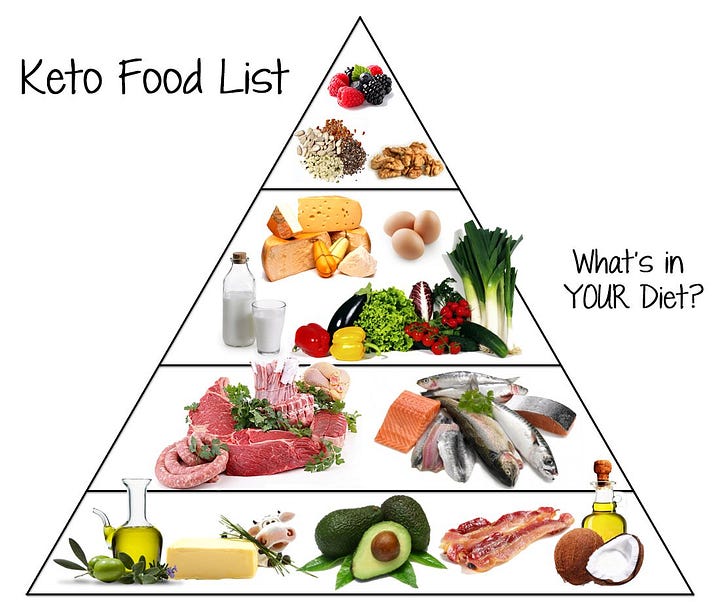With the increasing popularity of the keto diet, it may feel like everyone is talking about Keto diet benefits. The diet promises to transform your body into a fat burning machine and promote your overall health. This promise of Keto is what has led to its popularity in the last decade as one of the best weight loss strategies. We are yet to find out from various studies the truth on information surrounding the high-fat low carb diet as an elixir to aging.
What is a Ketogenic Diet (KetoDiet)
A sample Keto diet menu is high in fats, low in carbs and contains moderate amounts of proteins that puts your body in the state of ketosis.
How Does the Ketogenic Diet Work?
Once you get into the Ketosis state, the body changes in a manner in which it converts food into energy. The moment your body fails to obtain glucose from carbs, the liver takes over by converting fatty acids into Ketones, which is an alternative source of energy. When Ketones are produced, you are likely to lose weight and with no feeling of inflammation.
The Keto Food Pyramid
The standard food pyramid is a triangular representation of how much to eat from each food group to attain optimal health. Contrary to popular belief, some of these guidelines may be flawed or even confusing. As a result, for a somewhat balanced representation of how the Keto diet macro’s pyramid looks like, you only need to turn the standard food pyramid upside down.
Unlike the standard food pyramid, with a lot of carbohydrates at the base and fats at the very top, the keto diet macro food pyramid has fats at the base and carbs at the very end. The pyramid is based on the macro recommendation shown below:
- 5% of calories from carbs
- 25% calories from proteins
- 70% calories from fats
What to Eat on a Ketogenic Diet
Once you have decided to go Keto, it is vital that you know what should be on the Keto diet foods to eat and to avoid. A typical Keto food list consists of high-fat, moderate proteins and low carbs. Your sources of calories should be from food labeled as low carbs such as fish, eggs, vegetables, meat, and good fats.
Keto Diet Foods to Avoid
Any foods that are high in carbohydrates should not be on your Keto food list. The following food items should not be on your Keto diet meal plan.
- Sugary foods such as soda, smoothies, cake, candy creams, and fruit juice
- Avoid all fruits but limit small portions of berries.
- Grains and starches like pasta, cereals, and wheat based products.
- Beans and legumes such as chickpeas, lentils, kidney beans, etc
- If you are keen on having Keto diet vegetables and tubers, avoid potatoes, sweet potatoes parsnips, and carrots.
- Some sweeteners that contain sugars or unhealthy fats
- Trying to infuse Keto diet and alcohol may force you to reduce or avoid alcoholic beverages that may push you out of Ketosis.
- Sugar-free diet foods have very high sugar content and reduce the ketone levels.
Keto Diet Foods to Eat
You should have most of these foods on your keto meal plans.
- Red meat from ham steak, sausage, bacon, turkey, pork, and chicken.
- Fatty fish like the salmons, trout, mackerel, and tuna
- For a fresh supply of omega-3, add pastured whole eggs to your Keto diet foods to eat.
- Butter and cream from grass-fed animals
- Look for unprocessed cheese from goat, cream, cheddar, etc.
- Increase your energy levels by introducing nuts and seeds from almonds, flax seeds, walnuts, pumpkin seeds, etc.
- Cook your meal using healthy oils such as virgin olive oil, avocado, or coconut oil. Your avocado should be fresh.
- Vegetables should be green and leafy. You can also add tomatoes, and onions to the Keto food list.
- Condiments and or other Keto diet sweeteners like herbs, spices, salt, and pepper can also be part of additions to your Keto menu.
Sample Keto Diet Meal Plan
For a beginner for the first weeks, you will probably need trial and error to figure out a meal plan when doing keto.Here is a sample keto diet meal plan to get you started.
Breakfast
Choice 1: For a good source of protein and healthy fats start your morning with spinach, feta omelette, and mushroom. Use Keto coffee (one with added fats or bone broth) as an accompaniment.
Choice 2: If you are sure about your carb levels, try a combination of unsweetened yogurt, whole milk, and full-fat sour cream. You can also add a handful of chia seeds, raspberries, and walnuts. For this option note that yogurt contains lactose that can unsettle your carb levels. Make it more interesting by pairing it with two eggs to balance the macros
Lunch
Choice 1: How about a dose of heart-friendly fats by eating baked salmon with broccoli known for its low carb content but high in fiber
Choice 2: You can opt for a high-fat salad like the ranch or cheese, or look for bacon, cheese, avocado, pumpkin seeds, grapes.
Choice 3: Another Keto lunch option is to grill chicken, add a slice of ham, hard-boiled eggs, cheese cubes, and tomatoes. You can use raw vegetables like cauliflower or broccoli and guacamole.
Dinner
Choice 1: You can prepare a super filling dinner rich in protein by using the Caesar salad with lettuce, bacon, parmesan, and chicken breast. Dress this meal up using olive oil and plenty of cheese to increase the fat content.
Choice 2: Sauté grass-fed beef with onions and tomato sauce and serve it with zucchini or low carb noodles. If you want to maintain your ketosis, levels dress the zucchini in olive oil or garlic oil.
Choice 3: Healthier oils for fats such as heavy cream or coconut cream are ideal when added to grilled chicken served with eggplant and zucchini.
Snacks
Choice 1: For a perfect mix of fat and protein, roll up turkey and avocado using lettuce, bacon, tomato
Choice 2: Pick two cucumber slices, spread some cheese between them, and create a low carb keto snack.
Choice 3: You can also prepare a spicy guacamole and mix it well with slices of raw zucchini
The vegetables and meat can be eaten on rotation because each has its nutrients and health benefits.
What is Ketosis?
Unlike the usual metabolic reactions where the body acquires energy from food by breaking down glucose into energy, Ketosis is the process that involves your body burning fats to produce energy.
The breakdown means that your body is using the fat stores as energy. At this stage; you enter the Ketosis state, where your body does not have enough glucose or carbohydrates. When the carbohydrates intake becomes low, your body produces Ketones, which are the byproducts of Ketosis.
Benefits of Ketosis
It does not matter how long it took you to attain Ketosis. There are awesome benefits that go beyond shedding some fat. Because of the consistent supply of ketones from the liver to the brain, your mind is always alert. Ketosis gives you the benefit of never suffering from cravings or spikes because you lack something.
Whether or not you are a physically active person, while on Keto, your body is full of packed energy ready for deployment. If you workout regularly, you will be able to last longer in the gym, on the track, and do high-intensity workouts.
Ketosis symptoms
Many people get anxious when they change to Ketogenic diet; there is this urge that burns you to find out if your body has hit ketosis. Symptoms such as weight loss, loss of appetite, fatigue that does not last for long, constipation, and of course increase in the number of Ketones are an indication of the body being in ketosis.
What needs to be understood is that we are all different and the reaction of the liver getting energy from fat cells affects people in different ways. There is no single way that the same recipe can cause the same effect on different people due to individual bodily needs.
What are the side effects of Ketosis?
At the end of the day when the body’s natural source of energy changes from carbs to fats there is bound to be some side effects. Some of these problems may be transitional due to the change in diet.
The benefits you get from the Ketogenic diet should not lead you into overlooking the known Keto side effects. One of the most common side effects of the Ketogenic diet is the keto flu. Some of the symptoms of keto flu are brain fog, insomnia, irritability, nausea, stomach pains, muscle aches, and chills.
Keto flu will kick in within the first two to three days of getting into ketosis, and the symptoms may last for several weeks up to a month. The quickest remedy to get rid of these symptoms is to sprinkle some salt on food before your body gets used to the new lifestyle. Also, stay hydrated and get enough rest.
Other side effects include possible changes in the way your kidneys work, bad breath, constipation, changes in menstrual cycle and reduced bone density.
What are ketones?
During the breakdown of fats during ketosis, the body produces Ketones when acetoacetate is created after fat breaks down into energy. Because of this reaction, Beta-Hydroxybutyrate (BHB) forms through its structure is not similar to that of Ketones.
Ketone Supplements
Using Ketogenic supplements makes sense because the Ketogenic diet eliminates most foods from the table. These supplements contain some of the nutrients that other foods on the menu may not have. If you are not a ketogenic diet, supplements like the MCT oil, which is such a great source of energy will help you attain Ketosis within a short time.
Some of these supplements include magnesium, MCT oil, Omega-3 Fatty acids, Vitamin D, Digestive Enzymes, Exogenous Ketones, Greens Powder, and Performance Supplements. Do not consume too many supplements at the start because they cause some digestive issues.
When to use ketone Supplements
Ketones balance the sodium and other minerals in the body to help you fight the Keto flu. It is also possible to use these supplements to lose weight and use the ketones to power you through your workouts. Please note that Ketone supplements are still under study and the outcome may not represent what is expected.
Conclusion
As with any other diet, if the ketogenic diet works for you make sure you become consistent, remain focused, and enjoy the benefits of Ketosis.
For tasty keto fat bombs and snacks recipes purchase the Ketogenic Fat bombs: 57 Sweet and Savory High Fat, Low Carb Fat Bomb Recipes for Paleo, Keto and Low-Carb Diets (Keto Cookbooks).






Comments
Post a Comment